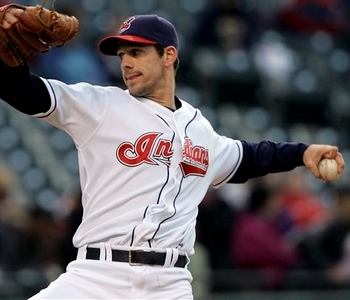I've published three other articles like this one that illuminate some interesting metrics observable in simple line drawings derived from score cards of the 2010 MLB Post Season.
- The Symmetry of a Perfect Game (On Roy Halladay's no-hitter)
- The Symmetry of Timothy LeRoy Lincecum's Complete Game 2-hitter (On Lincecum's 2 hit, 14 K Complete Game)
- The Symmetry of Cole Hamels' great start against the Cincinnati Reds
The Texas Rangers' pitching Ace, Cliff Lee has beaten the Tampa Bay Rays both times he faced them in this short Division Series, they were both effective starts, but Great? ... well, have a look at the numbers for yourself. Here's Cliff Lee's pitching line from the October 12th game, Tampa Bay's final game of 2010:
Here's the bottom half of the score card from last night's Game 5, Cliff Lee pitching all 9 innings, helping his team eliminate the Tampa Bay Rays.
Here's a line drawing I made from the score card above. It shows the number of batters Cliff Lee faced each inning; each vertical plane represents an inning. To help you see it I've made a list of the batters faced/inning:
1st inning - 4 batters
2nd inning - 3 batters
3rd inning - 6 batters
4th inning - 3 batters
5th inning - 4 batters
6th inning - 3 batters
7th inning - 4 batters
8th inning - 3 batters
9th inning - 3 batters
It's kind of boxy in the first half of the game it doesn't have that diagonal symmetry that all the other drawings I've made had. The 6 batter 3rd does that I guess. It's sort of like there are two different pitchers here, one before the 3rd and another pitcher later - rather than what we know, 9 innings from the great Cliff Lee. The second half of the drawing starts to resemble the softer pattern that represent what I've come to see in these line drawings as a great pitching performance.
What changed?
Good pitchers are able to adapt in game, if a particular pitch isn't hitting the spot intended, or an umpire is calling strikes on stuff that's half way to the moon for example, a battery may change what they're doing. Plus, hitters get used to a pattern; good pitchers change that pattern after 1 or 2 times through the order.
After the game Cliff Lee said that when he was warming up for the game, the curve ball was working great and that he knew he would be getting lots of outs with it. I wonder if by the 4th the battery figured out they would drop a pitch from the repertoire or perhaps just use the curve more?
I thought I'd check out that idea by going to Brooks Baseball page for Lee against all the Tampa Bay hitters in the game. Below is Brooks Baseball graph of pitch speed over the entire game, note the slow curve ball (that he throws with his index finger knuckled - see image above), is the 32nd pitch of the game. By reading ESPN's pitch by pitch of the game I counted that Cliff Lee threw 31 pitches in the first three innings. The slow curve was the first pitch of the 1,2,3 forth inning, representing the 5, 6, 7 hitters in the Rays line up - one and a half times through the order.
A battery can get behind hitters if the curve ball isn't hitting the strike zone, or if it's flat - riding up without a good drop through the hitting plane - the opposing batters will spank it out of the park on you. Interesting then that catcher Bengie Molina and Cliff Lee introduce the curve ball to the bottom half of the Tampa Bay order - to get it working before the line-up turns over?
***
Image of Cliff Lee's 'knuckle curve grip' on his curve ball from, ChrisOLeary.com
Thanks to Brooks Baseball PitchF/X for the chart: Pitch Speeds, Cliff Lee to Tampa Bay Rays over 9 Innings.
mh









No comments:
Post a Comment